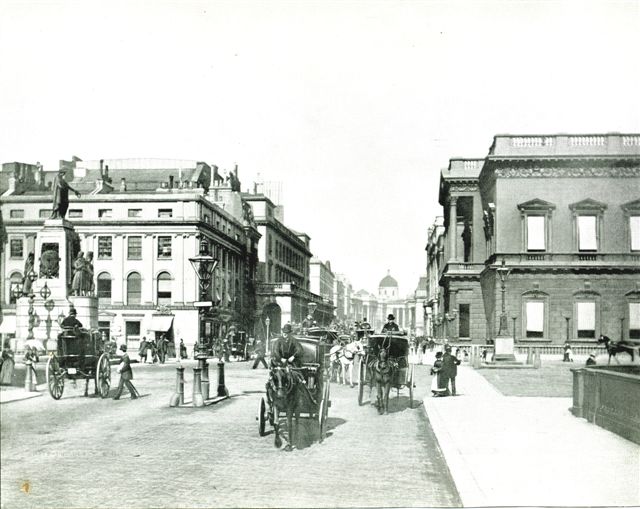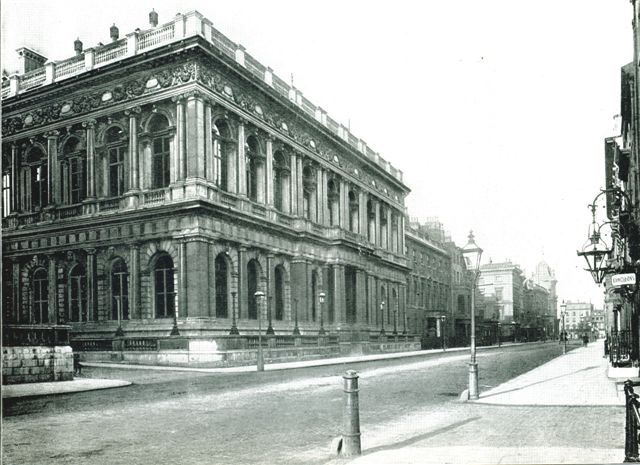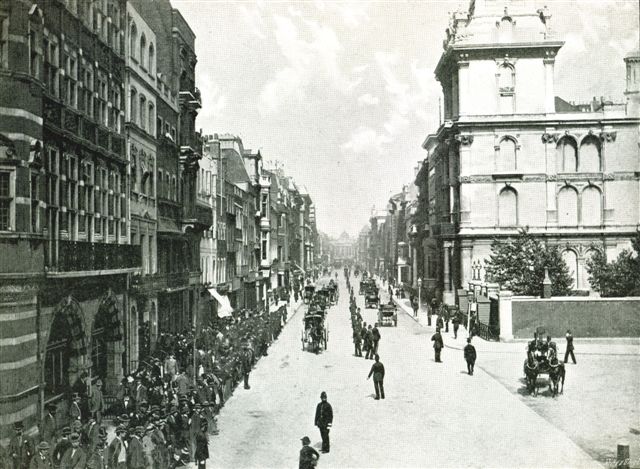|
|
|
 |
VICTORIAN AND EDWARDIAN 'AD' (3) Presented by Ex PC 799 'A'/164477 Leonard Bentley |
 |
|
Welcome to the third page of our personally escorted tour of Cannon Row Police Station's ground over 100 years ago. All photographs and descriptions are kindly presented by Ex PC 799 'A' Leonard Bentley and are from his personal collection.
|
|
 Waterloo Place Waterloo Place was laid out in 1816 and was the southern end of Regent Street leading to a view of Carlton House which stood on the south side of Pall Mall. Carlton House was demolished in 1826 and Waterloo Place was extended south towards the new Carlton House Terrace. In 1821 there was a proposal that Cleopatra’s needle be used as a centrepiece for Waterloo Place. The needle had been given to Britain in 1819 by the Khedive of Egypt but remained in the sand until it was brought to London in 1878. The building on the east side of Waterloo Place is the United Services club completed in 1827; the building was remodelled in 1842 and 1911 and is now The Institute of Directors. The building on the opposite corner site is The Athenaeum Club which is just out of shot, its members were and perhaps still are the intellectual elite of the country; it was completed in 1830 and looks much the same today except for and attic storey which was added in 1899 after this photograph was taken. On several occasions whilst posted to T. square I was approached by schoolchildren who had been given a written quiz containing questions regarding the area. The question which appeared to puzzle them most was the one about the stone blocks on the pavement outside the Athenaeum; these were placed there in 1830 at the request of the Prime Minister at the time, The Duke of Wellington, to assist in mounting his horse. The monument on Vine Street’s side of Pall Mall is The Guards Crimean Memorial erected here in 1860. The memorial was moved 26 feet northwards in 1914 to make way for the statues of Florence Nightingale and Lord Herbert. The building further east on that side with the colonnade is Her Majesty’s Theatre formerly known as The Italian Opera House; it was demolished in 1892 to make way for a new theatre of the same name and The Carlton Hotel. The hotel was demolished in 1957 to make way for New Zealand House. The Opera Arcade whose entrance is in Pall Mall was originally part of The Italian Opera House and dates from 1790. Yet again there is a Police officer in the photo, this time a sergeant is crossing to the south side of Pall Mall, he’s obviously been shopping. |
|
 The photograph (above) shows a quiet day in Pall Mall looking westwards, the junction on the left is Carlton Gardens with The Carlton Club on the far corner and The Reform Club on the near corner. There is no sign of Phineas Fogg; he’s probably half way round the world by now. The Carlton Club was designed by Smirke in 1836, but it was rebuilt in 1856; the club received a direct hit during the war and was not rebuilt. The Reform Club dates from 1841 and was designed by Sir Charles Barry of Parliament fame. The photograph (below) is of the old war office, most of the building dates from the eighteenth century, it became too small for its purpose and was demolished in1903 to be replaced by The RAC Club. The new war office was built in Whitehall on the site encompassed by Horseguards Avenue, Whitehall Court and Whitehall Place. The statue seen in the forecourt is of Lord Herbert who was minister for war under three prime ministers; he is most famous for allowing Florence Nightingale to go to the Crimea and he introduced many needed Army reforms. The statue was moved to Waterloo Place where it stands in front of The Guards Crimea memorial together with Florence Nightingale. The Hansom cab is probably the archetypal Victorian vehicle; it was designed by Joseph Aloysius Hansom in 1834. Hansom was an Architect and had won the competition to build Birmingham Town Hall but due to the contractor filing for Bankruptcy, Hansom was left with large debts. In order to allay his financial position, he invented ‘The Patent Safety Cab’ which at first had the driver sitting on the roof, however later modifications put the driver on the rear of the vehicle. The cab had no axle, the wheels were fixed to spindles which were attached to the suspension, and this enabled the cab to be very fast and manoeuvrable. Further refinements were made over the decades which followed including a driver operated lever to open the doors. One of the main manufacturers of the hansom cab was a firm called Forder who were based in Hinckley, Leicestershire; where Triumph motorcycles are made today. Persons who frequently used the Hackney cabs equipped themselves with a ’cab whistle’; if they required a Growler it was one blast and two blasts for a Hansom. It may have been this practice which to avoid confusion, led Police to give three blasts on the whistle to summon assistance. |
|
 War Office Pall Mall
|
|
 A Levee in Pall Mall The time is most likely mid morning on a Wednesday in April or May, early 1890’s. This was the weekday and the months when Levees were held at St. James’s Palace. Levees were receptions held by The Queen or The Prince of Wales at the court of St. James; they enabled the great and the good to meet and make or renew contacts and have a few words with Her Majesty or The Prince, The last Levee was held in 1939; today the Garden Party serves a similar purpose except that it covers a much wider cross section of society, although I have never been invited. I have counted upwards of forty officers in the photograph, but there are no prizes for the correct number. I think that they are probably on aid to Royal ‘A’; whenever I did the Garden Party the officers from other Divisions seemed to enjoy the change of pace and scenery, I always ended up doing traffic. On the right just out of shot is Marlborough Road and at this time known as Marlborough Gate. The Road was opened to the public in 1856 and in 1925 a pavement was added to the west side after complaints were made about the dangerous approach to the crossing on The Mall at the infamous 61 traffic. The entrance to Marlborough House can be seen on the right with the sentry boxes outside, since 1850 it had been the home of the Prince of Wales, later Edward VII. The building next to the entrance is The Guards Club which dates from 1875, as it overlooked Marlborough House it was built with blind window openings on that side. The lack of natural light forced the club to move to a sunnier aspect after only three years; the building was demolished in 1930 and replaced by two banks. It may have been at this time when the entrance to Marlborough House was pushed back to The St. James’s Palace building line; or it may have something to do with damage caused to one of the banks during the blitz. The building on the left at the corner of Pall Mall and St. James’s Street is by Norman Shaw, the architect of New Scotland Yard and dates from 1882. The building in which the cameraman is perched was replaced by another Norman Shaw building in 1903. |
|
 Lancaster House Above is a view from the garden which backs onto The Mall. Lancaster House was built on the site of Godolphin House a 17th century building; when The Duke of York moved into the building in 1807 he renamed it York House and when his father George III died and he became heir to the throne and needed a more suitable house he engaged Robert Smirke to build it. Unfortunately George IV disliked Smirke’s plans and replaced him with Benjamin Wyatt who commenced building in 1825. The Duke of York died before its completion and the building was sold to the Marquess of Stafford who renamed the building Stafford House. During the 19th century the house received many distinguished visitors including Chopin who played there, William Garrison the American abolitionist and Garibaldi the Italian revolutionary. In 1912 the house was sold to Lord Leverhulme who renamed the building Lancaster House and gave it to the nation in 1913. Until 1946 the building housed The Museum of London and is now used for Government receptions and conferences. In 1979 the Rhodesia peace talks were held here and a contingent of officers from all the ’A’ Division stations were stationed in the Arcade which is the building on the other side of Stable Yard from Lancaster House. The Arcade was originally a stable block and dates from 1717 and was designed by Nicholas Hawksmoor the famous protege of Wren, it is one of his few secular buildings to survive. It was about this time that restoration work started which has virtually ruined the building. I only spent one night on duty there watching the CCTV screens and found it very boring; the old hands found other ways to make their duty more interesting including metal detecting in Green Park during grub breaks. The photograph of St. James’s Palace (below) could have been taken yesterday except for the Growler and the ornate lamp standard and bollards. Whenever I was posted to eight protection which seemed like all the time, the clock tower gateway was never open but the gateway to Ambassadors Court was; it has been shut for security reasons for some years. The officer just to the right of the Growler looks ready for his meal break, but I doubt whether he had time to walk back to King Street. The Guards mess was always very hospitable to officers on eight protection in my experience. |
|